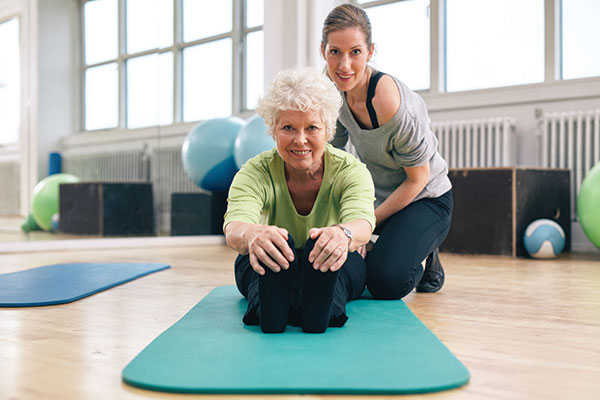How to Make Exercise a Part of Your Post-Cancer Life
by Nancy Campbell, MS
It has been six years since the American College of Sports Medicine published their recommendations that all cancer survivors should strive to avoid inactivity. Since then, research has continued to show that rates of cancer recurrence are lower in survivors who are physically active on a regular basis. Not only that, but regular exercise has been shown to help ease many of the side effects of cancer treatment.
In fact, exercise is one of the most important activities you can pursue to give yourself an extra boost during and after cancer treatment. And the good news is you don’t have to become an elite runner or join a CrossFit gym to reap the benefits. You just need to add physical activity into your daily routine. Here are some tips to help you get started.
Start low and go slow.
Before you start exercising, you should check in with your medical team to make sure they don’t have any concerns about you beginning an exercise program. Once they have given you clearance, it is important to start slowly. And make sure your activity is enjoyable, not exhausting.
As you begin establishing a routine, set yourself up for success by finishing each round of exercise knowing you could have done a little bit more. You want to avoid doing a big bout of activity that leaves you exhausted and unable to exercise again a day or two later while your body is recovering from treatment. As you get stronger, try exercising in two or three 10-minute bursts over the course of the day.
Keep track and set goals.
There are so many ways to keep track of your progress with exercise. Maybe it’s a calendar on your refrigerator or a wearable activity tracker, like Fitbit. The main goal of tracking your exercise is to keep you aware of how much activity you are getting and to remind you to stay active.
Fighting Fatigue with Exercise
Fatigue is one of the most common and frustrating side effects of cancer treatment, and exercise is one of the best ways to boost your energy. It seems counterintuitive, but even a short walk around your house, or to the end of your driveway and back, can help take the edge off cancer-related fatigue.
In the beginning, it’s best to focus on being consistent with your exercise routine, rather than worrying about the duration or intensity of your workout. This will help your body gradually adjust to incorporating activity into your lifestyle.
Exercise should also be more than a single event in your day. The goal is to stay as active as possible throughout the day. Look for creative ways to add more movement into your day. For example, many activity trackers will alert when you have been inactive for more than an hour. You could also set a reminder on your phone or your computer that signals you to get up every hour and move around. Another tip is to park farther away when you are running errands, or get off the bus one stop earlier and walk that extra block.
Exercise should be more than a single event in your day. The goal is to stay as active as possible throughout the day.
Many people find it useful to set a daily or weekly exercise goal to keep them on track. Just make sure that your goal is S.M.A.R.T.:
- Specific
- Measurable
- Attainable
- Relevant
- Time-bound
For example, instead of saying “I will exercise more,” try setting a more concrete goal: “I will walk for 20 minutes at 10 o’clock on Monday, Wednesday, and Friday mornings.” Setting goals like this will keep you moving forward as you are focusing on making small changes that will help you reach your overall wellness goals.
Look for resources.
Many different programs are available to help cancer survivors stay active. For example, YMCAs across the country offer LIVESTRONG at the YMCA, a 12-week physical activity program designed to get cancer survivors back on their feet. In addition, many hospitals and wellness centers offer movement classes that are designed for cancer survivors. Check with your healthcare team to see if one is available in your area.
If you are struggling with side effects from treatment, like neuropathy, that make it difficult to exercise, a physical therapist, occupational therapist, or cancer exercise specialist can help tailor an exercise program to meet your unique needs.
Don’t be too hard on yourself.
Be kind to your body as you are recovering from treatment and easing into exercise. I always say, 10 percent of something is better than 100 percent of nothing.

Nancy Campbell is an exercise physiologist who offers fitness consults and classes to cancer survivors through Dana-Farber Cancer Institute’s Adult Survivorship Program and Zakim Center for Integrative Therapies in Boston, MA. For more information, visit DanaFarber.org/exercise.
Many hospitals are now researching exercise and have clinical trials that you may be eligible for. These can be a great tool to help you get active or stay motivated as you pursue physical activity. You can find these trials by visiting ClinicalTrials.gov and entering exercise and cancer in the search box.
This article was published in Coping® with Cancer magazine, November/December 2016.


